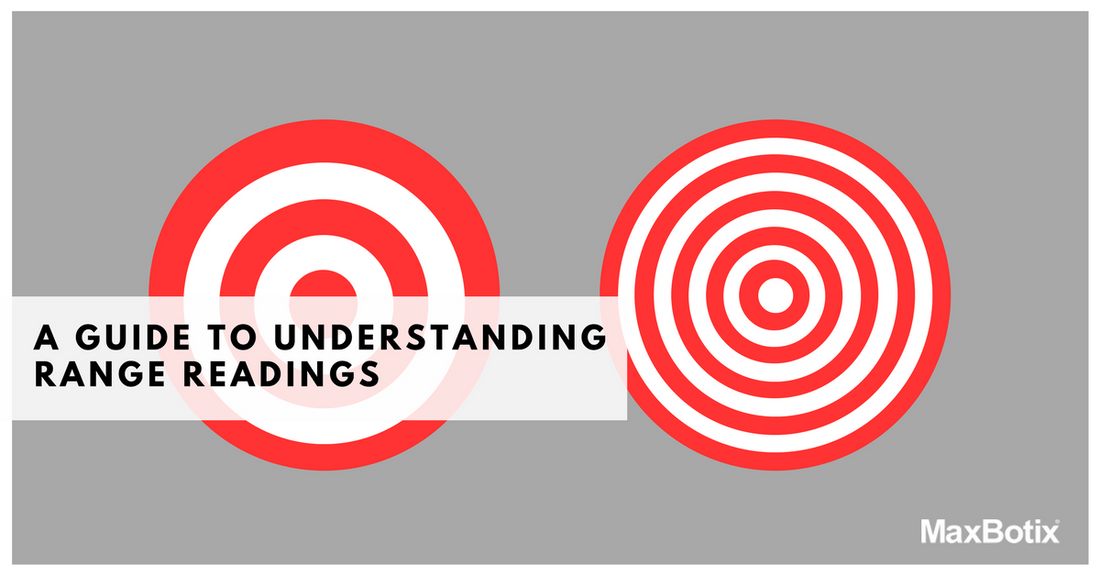Key Takeaways
- Resolution indicates the smallest reading or change in readings that can be reported
- Precision indicates the smallest reading that can be taken repeatedly and reliably
- Accuracy indicates how close the reading is to the true distance
When it comes down to it, you purchase a rangefinder for the range readings. The success of an application may hinge upon knowing the exact location of a target. However, a sensor may report one meter even if the target is not exactly one meter away from the sensor. Sensor specifications, such as resolution, precision, and accuracy, help us understand what wiggle room and error will be present in a reading.
Resolution
 The sensor resolution indicates the smallest measurement or change in measurement that the sensor can report. Figure 1 shows two targets to help you conceptualize different resolutions by thickness and number of bands on a set of targets. A sensor with ten cm (100 mm) resolution would report one meter if it sees the target sitting anywhere between 950 mm and 1050 mm. This means that one meter will be reported as long as the target is seen as sitting anywhere in that ten cm (100 mm) band. Instead, if the sensor has a one-millimeter resolution the target would be seen as sitting between 999.5 mm and 1000.5 mm. Selecting a sensor with sufficient resolution is important for applications where fine and near exact range readings are required.
The sensor resolution indicates the smallest measurement or change in measurement that the sensor can report. Figure 1 shows two targets to help you conceptualize different resolutions by thickness and number of bands on a set of targets. A sensor with ten cm (100 mm) resolution would report one meter if it sees the target sitting anywhere between 950 mm and 1050 mm. This means that one meter will be reported as long as the target is seen as sitting anywhere in that ten cm (100 mm) band. Instead, if the sensor has a one-millimeter resolution the target would be seen as sitting between 999.5 mm and 1000.5 mm. Selecting a sensor with sufficient resolution is important for applications where fine and near exact range readings are required.
Precision
Precision sensors, which are also known as reading-to-reading stability, tie in closely to resolution. Where the resolution of a sensor explains how fine of a reading the sensor takes, precision explains the reliability and repeatability of these readings. Let us look at a sensor with mm resolution. Imagine taking three readings to the same fixed target: 974 mm, 995 mm, and 1005 mm. Even though the part reports distances down to the millimeter, the precision limits the reliability of these readings. In cases with limited precision, it may be best to treat the readings as if they had a more limited resolution to restore precision. The readings from the previous example become a very stable 100 cm, 100 cm, and 100 cm if we treat the readings as if they had 10 cm resolution rather than millimeter resolution. MaxBotix Inc limits resolution to provide high precision as found in the bottom two targets in Figure 2. Some manufacturers offer high resolution without high precision.
Accuracy

It is important to understand that neither resolution nor precision is sensor accuracy. Resolution and precision give you an idea of the finest measurements a sensor can reliably report. Accuracy compares the true distance to the distance reported by the sensor. A sensor with high accuracy will report a distance close to the true distance. Even if a sensor has very high resolution it may not be very accurate. However, if a sensor has high precision, you may be able to correct the readings to make them accurate. Consider the bottom left target in Figure 2 if we shift the Xs up and to the right, we can make them both precise and accurate as seen in the bottom right target. Similar transformations may be applied to range readings. If a sensor has high precision, you can calculate the average offset between the reported reading and the true range and add that to the reported readings to yield higher accuracy.
Comparing the needs of your application to the specifications of a sensor is one of the steps involved in sensor selection criteria. MaxBotix Inc offers a range of products with diverse specifications to help you as the customer select only what you need for your application. This helps you to pay for only the features you need. If you have any questions about a sensor's specifications, our technical support team. We will be more than happy to help.
Products Related to the Article:
MB1013 HRLV-MaxSonar-EZ1
Features of the MB1013, HRLV-MaxSonar-EZ1, include millimeter resolution, a great blend of sensitivity as well as side object rejection, range information from 300mm to 5000mm, a 10Hz read rate, and various output options: pulse-width, analog voltage, and a choice of either RS232 or TTL serial.
Buy NowMB7380 HRXL-MaxSonar-WRT
Features of the weather resistant MB7380, HRXL-MaxSonar-WRT, include millimeter resolution, ultrasonic sensor range information from 300mm to 5000mm for the nearest detectable target, a 7.5Hz read rate, and various output options: pulse-width, analog voltage, and TTL serial.
Buy NowMB7380 HRXL-MaxSonar-WRT
Features of the weather resistant MB7380, HRXL-MaxSonar-WRT, include millimeter resolution, range information from 300mm to 5000mm for the nearest detectable target, a 7.5Hz read rate, and various output options: pulse-width, analog voltage, and TTL serial.
Buy Now




